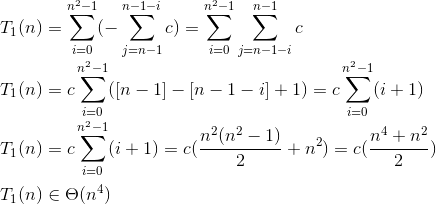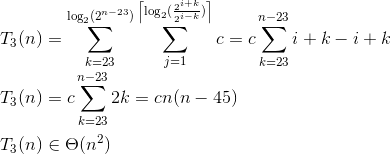问题
I'm pretty new to the Big-O field, so bear with me here. I have been searching about it as much as I could but I still need a lot of work to fully understand it.
I came across these nested for loops in a practicing exercises and there wasn't any solutions and they seem complicated. So, any help would be appreciated.
1)
int sum=0;
for(int i=0; i < n^2; i++) { // n+1
for(int j = n-1; j >= n-1-i; j–-) { // n(n+1)/2 ?
sum = i+j; // n(n+1)/2 ?
System.out.println(sum); // n(n+1)/2 ?
}
}
Big-O = ?
2)
int sum=0;
for(int i=1; i <= 2^n; i=i*2) { // log(n)
for(int j=0; j <= log(i); j++) { // log(n(n+1)/2) ?
sum = i+j; // log(n(n+1)/2) ?
System.out.println(sum); // log(n(n+1)/2) ?
}
}
Big-O = ?
3)
int sum = 0; int k = 23;
for(int i=k; i <= 2^(n−k); i=i*2) { // log(n)
for(int j=2^(i−k); j < 2^(i+k); j=j*2) { // log(log(n)) ?
sum = i+j; // log(log(n)) ?
System.out.println(sum); // log(log(n)) ?
}
}
Big-O = ?
4)
int sum=0;
for(int i=2n; i>=1; i=i/2) {
for(int j=i; j>=1; j=j/2) {
sum = i+j;
System.out.println(sum);
}
}
Big-O = ?
EDIT:
- Corrected #4. Sorry for the mess up.
- Base of the log is 2.
- The ^ here means "to the power", not xor.
回答1:
There are plenty questions like "Big-O of nested loops" here on stackoverflow (and answers).
However, you will get an answer from me. But first there is a notation problem:
You tagged this question as java. In the code I see something like 2ⁿ or n². In java this means xor, but I think you meant Math.pow(2,n) instead, so for this answer I will treat it as a power operator.
int sum=0; for(int i=0; i < n^2; i++) { // outer loop for(int j = n-1; j >= n-1-i; j–-) { // inner loop sum = i+j; // inner operations System.out.println(sum); } }The inner operations runs in
O(1), so I just counting how often they are called.- The outer loop runs
n²times. - for each
i(from the outer loop) the inner loop runsitimes.
In total you get
0+1+...+(n²-1)+n² = n²(n²+1)/2. This is inΘ(n⁴).- The outer loop runs
int sum=0; for(int i=1; i <= 2^n; i=i*2) { // outer loop for(int j=0; j <= log(i); j++) { // inner loop sum = i+j; // inner operations System.out.println(sum); } }- The outer loop runs
ntimes, since2⋅2⋅2⋅...⋅2(ntimes) equals 2n. - The inner loop runs
ktimes for each i=2k (1 ≤ k ≤ n), assuming the base of the logarithm is 2.
In total you get
1+2+3+...+n-1+n = n(n+1)/2. This is inΘ(n²).- The outer loop runs
int sum = 0; int k = 23; for(int i=k; i <= 2^(n−k); i=i*2) { // outer loop for(int j=2^(i−k); j < 2^(i+k); j=j*2) { // inner loop sum = i+j; // inner operations System.out.println(sum); } }- The outer loop runs
mtimes withmminimal such thatk⋅2m > 2n-kholds. This can be written ask⋅2k⋅2m > 2n.khas to be positiv (otherwise the outer loop will run forever). Assumingkis bounded byO(n)(canstants are also inO(n)),mis also bounded byO(n). - The inner loop runs always
2⋅ktimes, no matter whatiornis. This is inO(1)for a constantkand inO(n)for akbounded byO(n).
In total you get
O(n)for a constantkandO(n²)for akinO(n).- The outer loop runs
int sum=0; for(int i=2n; i>=1; i=i/2) { // outer loop for(int j=i; j>=1; j=j/2) { // inner loop sum = i+j; // inner operations System.out.println(sum); } }- The outer loop runs
log(n)times just like in case 2 (the other way around) - The inner loop runs
jtimes for (basicly) each power of 2 between1and2n.
Assuming
n = 2k(meanslog(n) = k) you get in total2k+1+2k+2k-1+...+22+21+20=2k+2-1=4n-1. So this in inO(n). This also holds for n not a power of 2.- The outer loop runs
回答2:
Methodically finding a solution for your iterative algorithms using Sigma notation:

Using base 2 for the log below:



来源:https://stackoverflow.com/questions/26569408/big-o-of-these-nested-loops